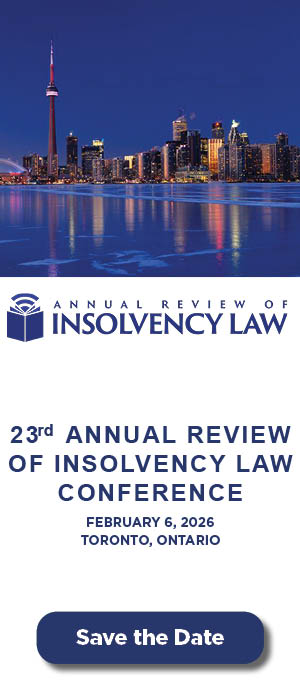Rebuilding Success Magazine Features - Fall/Winter 2025 > Strategies for Realizing on Commercial and Residential Real Estate
Strategies for Realizing on Commercial and Residential Real Estate
 |
By Jeffrey Oliver, Partner, Cassels, Brock & Blackwell LLP; Vanessa Allen, Senior-Vice President, MNP Ltd., and Liam Brunner, Principal, Senior Director and Western Canadian Leader, Valuation & Advisory, Avison Young
Introduction
2024 saw an increase in insolvency filings with notable challenges being reported in the real estate industry. High interest rates, high construction costs increased development costs and delays in obtaining permits/ rezoning contributed to failures in this sector. During the first half of 2025, real estate related insolvency filings have been reported as follows:
-
While for the 12-month period ended May 31, 2025, business insolvencies (bankruptcies and proposals) for real estate, rental and leasing were relatively flat, decreasing approximately 4% compared to the prior year, the 12-month period ended May 31, 2024, saw a 42% year over year increase1; and
-
For the first half of 2025, there were 30 receivership filings reported in Canada of which 24 were reported in Ontario. If filings remain relatively consistent for the remainder of 2025, we are likely to see an increase over 2024, during which year there were fifty-five receivership filings in the real estate industry, of which 39 were in Ontario2.
Market Highlights
While a detailed market analysis is outside of the scope of this article, we note the following existing and forecast real estate trends across Canada:
Existing Trends
While expectations have improved slightly, there continues to be muted activity in the office and multi-family sectors. The industrial sector remains the strongest segment in the Canadian real estate landscape. In particular, we note the following:
-
For office, vacancy rates remain largely flat or declining. In Q1-2025 vacancy rates ranged from 8.8% in Winnipeg to 21.9% in Calgary3. The availability of sublet space continued to decline as tenants increasingly favoured new leases at comparatively low lease rates.
-
For muti-family residential the high cost of construction for higher density developments has curtailed higher built form properties adding to the housing supply deficit seen in Canada and most developed economies. It is worth noting that demand is improving as inflation has stabilized, interest rates have decreased, and employment rates have improved.
-
The industrial market remains strong despite softening leasing activity nationally. While economic uncertainty remains a deterrent for tenants, industrial real estate investment continues to lead the commercial market.
2025/26 Forecast
The forecast for the coming year reflects an overall improvement in fundamental conditions and increased debt availability4; however, challenges are still expected for office and muti-family residential real estate:
-
For office, continued challenges are expected outside of for desirable trophy buildings and there will be an ongoing emphasis on unique amenities and building upgrades that provide for enhanced tenant experiences5.
-
For muti-family residential, reduced construction activity is expected in the short-term due to decreased immigration, recent supply increases in some markets and a flattened outlook for rent growth6.
Ongoing challenges reflect the need for both lenders and insolvency practitioners to demonstrate patience and creativity in developing unique realization strategies for these properties in order to maximize value.
Key Considerations in Assessing the Path Forward
In assessing recovery options for both office and residential assets, the following are some of the key considerations surrounding maximizing value for lenders:
-
Required work to complete the project or repairs/ renovations to enhance market appeal:
-
Completing partially constructed projects may significantly mitigate losses, provided required expertise is available. Some lenders may have this expertise in house, others do not. We note that this must be considered on a case-by-case basis by reviewing the costs to complete vis a vis any incremental increase in the purchase price.
-
The flight to quality office space/ improved tenant experience requires landlords to be increasingly thoughtful in upgrading older properties, including common area spaces and amenities.
-
-
Careful consideration of the overall rental strategy for the property - While undesirable vacancy rates may negatively impact the value of real property, so too can the addition of a tenant or the provision of lease rates which do not support the overall market placement and communicated value proposition of the building. For example, while some tenant incentives may appear favourable in the short-term, they may create a precedent for future negotiations that impact a property’s overall profitability.
-
Other sources of realization - additional sources of recovery may be available in various forms. We note the following:
-
Deposits held by insurance providers or municipal or provincial bodies, the release of which may be tied to specific development milestones.
-
An alternate example in the case of a commercial property, involves the receivership of a downtown-Calgary office building known as Plaza 1000. In this case, a tenant had negotiated a lease prior to the receivership and then decided to surrender that lease. Following negotiations with the Receiver, a settlement was concluded that resulted in approximately $1.5 million being realized for the estate based on that formal surrender.
-
Reverse vesting orders have also been used as a tool in real estate transactions to preserve tax benefits, thereby enhancing creditor recoveries. In particular, the B.C. Court of Appeal recently upheld a decision granted in the matter of British Columbia v Peakhill Capital Inc. approving the use of a reverse vesting order in structuring a transaction to avoid payment of British Columbia’s property transfer tax7.
-
-
Market conditions – as noted above, while some uptick in demand for multi-family properties is expected in 2025 both commercial and multi-family properties continue to experience challenges. Below are some related considerations:
-
Slower demand may require lenders to adopt a longer-term and/or non-traditional strategy. For example, municipal subsidies may warrant further consideration of alternate use scenarios. In Calgary, where reported office vacancies were the highest, the Downtown Development Incentive Program provided up to $75 per square foot of office space that was converted into residential use (up to a maximum of $15.0 million per project)8.
-
While market conditions are more variable for residential properties, realization strategies must be tailored to the specific geography. Local realtors may use platforms like Final Offer9, which provides a competitive bidding platform where offers are pending for residential real estate. In a hot market, these platforms can be used to inflate the final sale price whereas in slower markets, they can be used to build market interest.
-
In some geographies, high construction costs may impact the feasibility of completing required renovations/ construction.
-
-
Potential cost savings – Where a property has been mismanaged or is bound by unfavourable contracts, significant cost savings may be achievable through the disclaimer or renegotiation or existing agreements. As another example, property tax savings may be achieved by challenging existing assessments, noting that lowering the assessed value may impact the perceived realizable value in some cases.
Preserving Future Value
While insolvency proceedings generally favour a shorter timeline that allow lenders to quantify their losses and limits professional fees, a longer-term view is increasingly required to preserve value. More creative realization strategies may include the following:
-
Extending Court proceedings – While some of the initial benefits of a Court proceeding include a) preserving the real property, b) allowing for the termination of any unfavourable contracts and c) allowing for Court access to address any mid to long-term issues with third-parties (associated condominium corporation(s), relevant municipal and provincial government bodies etc), in selected cases, it may make sense to extend the Court proceedings to allow for the implementation of a long-term realization strategy. Again, the costs and benefits of such a strategy must be considered on a case-by-case basis.
-
Long-term forbearance agreement with the debtor company. As an example, in October 2023, a receivership was initiated in respect of a large commercial building in downtown Calgary known as Stephen Avenue Place. Based on subsequent discussions between the debtor and the lenders and an assessment of short-term realization options, the building was transitioned back to the debtor in January 2024 pursuant to the terms of a long-term forbearance agreement. This outcome is intended to allow both parties to the opportunity to achieve an enhanced recovery through the implementation of a longer-term holding strategy.
-
The completion of a credit bid whereby the lender obtains ownership of the real property for the purpose of holding the property indefinitely until selling conditions improve. This outcome provides the lender with various opportunities to maximize value, including the following:
-
The ability to implement a longer-term marketing strategy, which may reduce any real or perceived urgency to transact;
-
The implementation of an updated long-term property management strategy, which can be structured to incentivize the achievement of agreed upon outcomes.
-
The ability to oversee longer term construction/ projects.
-
Where quality enhancements may not provide the desired value proposition, municipal subsidies may warrant further consideration of alternate use scenarios.
-
Consideration of the overall rental strategy. For example, the cross-border insolvency filing for WeWork raises questions around the viability of shared workspace operators and highlights considerations around the most favourable structure for shared workspace arrangements.
-
It is noteworthy that where a longer-term holding strategy takes the form of a credit bid, the preceding receivership may allow the lender to benefit from the use of service providers sourced in the receivership proceedings and the orderly transition of the property from the receiver to the lender.
Conclusion
In conclusion, market challenges faced by both commercial and multi-family real estate require both lenders and insolvency practitioners to consider creative, comprehensive and, in many cases, longer-term realization strategies to maximize the value of these assets.
1 Government of Canada, “Insolvency Statistics – May 2024; Table 3: BIA Insolvencies Filed by Businesses”
2 Insolvency Insider Canada – Filing Database
3 Avison Young, “Calgary Office Market Report: Q1 2025”
4 CBRE Research, “2025 Canada Real Estate Market Outlook” (January 2025) online: https://www.cbre.ca/-/media/project/cbre/dotcom/americas/canada-emerald/insights/canada-market-outlook/2025-Canada-Real-Estate-Market-Outlook.pdf, page 16.
7 Peakhill Capital Inc. v Southview Gardens Limited Partnership, 2023 BCSC 1476
8 City of Calgary, “Revised Downtown Calgary Development Incentive Program Terms of Reference” (2023), page 2.
9 Final Offer, “Final Offer Launches in Canada Bringing Transparency to the Canadian Real Estate Market” (April 25, 2024).
